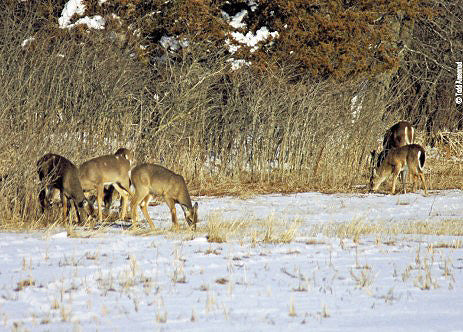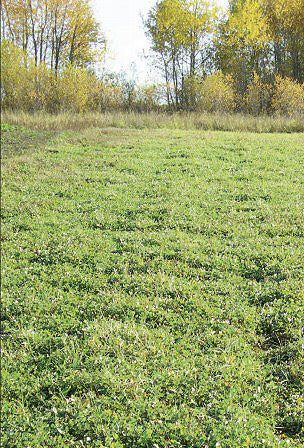
SPRING FOOD PLOTS HELP WHITETAILS RECOVER FROM STRESS
Keri Butt | Originally published in GameKeepers: Farming for Wildlife Magazine. To subscribe, click here.
Winter is undoubtedly the most stressful time on the whitetails’ calendar, particularly for herds in the northern regions. Sure, every season brings with it some difficult conditions that deer must outlast. Thankfully, their God-given resilience and adaptability are second to none. However, winter, especially an exceptionally harsh winter, can have debilitating effects on deer long after the last of the snow melts.
While freezing temps, deep snow, and driving winds play a huge part in the “misery factor” for northern whitetails, those are nothing compared to the loss of nutritional forage they face head-on when winter sets in. The harsher the winter is the worse the side effects. Of course, one way to help deer come out on the winning side of this season is winter and spring food plots.
During the late summer of 2013, I planted three separate cold weather plots. In one, I used BioLogic’s Last Bite, which is a smorgasbord of forage triticale, cold tolerant oats, winter wheat, annual clover, and two different maturity rate brassicas. Another plot is a combination of Biologic Trophy Oats and Deer Radish. The last plot is planted in Biologic Maximum, Winter Bulbs and Sugar Beets, and Deer Radish. Each of these plots is a solid, snowy canvas of deer tracks and droppings as of late February 2014.

Fall and winter food sources like these are important to help them keep healthy through the winter, but having something there in the spring is possibly more important.
A perennial of some sort can be “the plot that saves the herd” when spring rolls around. Sure, there may be leftover beets or radishes in the ground and maybe some corn remnants, but to have something producing right away in the spring makes a huge difference. Many people think – the woods and all the plants are turning green so the danger for the whitetails has passed. However, most don’t understand that native vegetation will average between 7 and 9 percent protein – nowhere near what a whitetail needs to flourish. The perennials (clovers, alfalfa, chicory, etc.) will give them over 20 percent protein. Even if you’re planting annuals right away in the spring, it will be six weeks before anything grows enough to be a viable food source for your herd. So perennials are a definite key to an all-around food plot strategy.
Perennials are important, but we’re talking about “spring” plantings and in the south (and through a portion of the transitional zone) perennials should be planted during the late summer or fall. Regardless of when they’re planted, they are utilized by your herd during the spring, before many other crops are even planted in the ground. Sometimes in the south, perennials are planted during the fall, they pop up in the spring and then are left to die off in the hot, dry summer. None the less, they’re still a vital component of a springtime nutrition plan.
Oftentimes by the time spring arrives, we find that our winter plots simply weren’t enough. Winter food supplements afford deer with food rich in carbs to help them maintain and hopefully sustain body mass when natural forages are extremely limited. Unfortunately, just because a deer survives the winter doesn’t mean it isn’t worse for the wear, its physical condition can be seriously depleted. This is bad for various reasons and sometimes can be the catalyst for problems over the next several months, even years.
For bucks, one of their primary needs for nutrition begins anew every spring - the development of a fresh set of antlers. This process requires an exceeded intake of protein-rich nutritional forage. Between the fall rut and the harsh winter, by the time temps begin to warm up a buck’s physical condition can be dwindling rapidly, if they made it at all. If their nutritional demands aren’t met, not only will their physical condition continue to decline, but antler growth will suffer as well, possibly even in subsequent years.
Does, on the other hand, must have their nutritional demands met for the sake of their fawns. If these demands aren’t received, malnourishment can occur, causing a doe’s body to re-absorb her unborn fawn(s). Fawns that are born unhealthy and/or at a low birth weight will have a rough start in life and are much more prone to an untimely death, become victims of predation, or even be abandoned by their mother. Added nutrition also helps does produce an ample milk supply full of proper nourishment that fawns need to mature into healthy adult deer.
So, how can we help deer recuperate from the stressful demands of old man winter? We can obviously begin a supplemental feeding program, where legal. However, planting food plots can help like nothing else can. The nutrition that food plots provide cannot be rivaled by any other source.
Your Soil’s Potential for Growing Antler and Venison
An experienced wildlife farmer will tell you that a soil test is one of the most crucial components to an accomplished plot regardless of what your goals may be. Your soil needs to be able of sustaining the food source you’re planting in it.
The results of a soil test will give you vital information on a few things: First, a soil analysis will give you the results that correspond specifically with your soil. The pH level is the measurement of acid in the soil; the higher the acid, the lower the pH level and vice versa. Phosphorus, potassium, and organic matter levels will also be noted.
Secondly, you’ll learn the optimum range your specific crop levels should fall between, determining if your levels are high or low. This will govern the amount of lime and fertilizer necessary, and the results will help to fine tune this, giving you a near exact amount of lime and fertilizer you should incorporate as well as the appropriate fertilizer NPK ratios.

pH is the measure of how acidic your soil is, and is recorded on a special type of scale that ranges from 0-14. The lower the level the more acidic the soil, while higher pH levels would make for more alkaline in the soil, with a level of seven being neutral. Some soils are more nutrient-abundant than others. It’s not that other grounds aren’t or can’t be just as viable, it’s just that a little extra care may be needed first.
You can pour as much fertilizer as you want on a food plot, but you’ll be wasting time and hard earned money if the soil isn’t able to access its benefits because of high acidic levels which causes individual soil particles to adhere tightly together with the nutrients in the soil, thus making it near impossible for the plants to utilize those nutrients to their full potential. This is where the importance of soil analysis comes in and why incorporating lime, if necessary, can be so important. The nutrients in the soil or the nutrients in your fertilizer are ultimately the nutrients that travel through the plant’s root system, into the plant’s leaf and end up as antler and venison in your whitetails.
The Limiting Factor
The pH of your soil is arguably more important than fertilizer. Lime is going to be your best bet when trying to attain favorable pH levels. When determining how much lime you’ll need to add to your soil, the quintessential word is balance. Too high of a pH level can be just as detrimental as too low, and can cause the good “bacteria,” to grow too quickly, causing it to diminish the critical micronutrients needed for optimum growth. The results will tell you exactly how much lime and fertilizer you will need to add prior to planting. Knowing what your soil is comprised of and the ratio of sand to soil is crucial. A new food plot could possibly need several tons of ag lime per acre to bring the pH up to preferred levels. The optimum pH level should be somewhere in the range of 6.0-7.5.
Kill the Weeds to Grow your Seeds
Whether you’ll be planting a new whitetail food plot or improving or changing an existing one, weeds aren’t just a nuisance. They’re a downright problem. They can and will overtake, choke out and hoard vital nutrients that new seedlings need to survive. Unfortunately, this is where the costs of food plots can soar. But, there’s a big “however” involved here, because the truth is that if you don’t eliminate weed competition, you can broadcast as much seed as you can afford, but if the seed doesn’t even stand a chance of maturing, you may as well save the money and the trouble. You’ll want to use a nonselective herbicide such as Roundup (glyphosate) to kill all existing or remaining vegetation prior to planting.
Austin Delano, Wildlife Manager with Mossy Oak Biologic gives this advice. “Of the plethora of herbicides available, only a handful have a big role in food plot management. Clethodimand Sethoxydimare the active ingredients found in herbicides used for killing grasses in legume crops such as clover, alfalfa and beans. Clethodimcan commonly be found as Section, Select, or Arrow brand names. Sethoxydim can be found as Poast or Poast Plus. For optimum weed control, spray once after spring green up to kill existing vegetation, wait a week and then run over with a disk or tiller over the plot to disturb the ground. Wait an additional week to ten days for a second weed flush to carpet the plot and then spray with glyphosate before planting. This often eliminates having to do any weed control after planting.”
Don’t Skip the Fertilizer

As said, the nutrients sucked up through the plant is ultimately the nutrients that go to growing big antlers and large body weights, but fertilizing your plot, especially a large one is usually the most costly component of planting a food plot. Your soil analysis will give you the fertilizer type that will work best for your soil. Fertilizer is made up primarily of three elements that are categorized in this order: nitrogen, phosphorous and potassium (and sometimes also Sulfur). Fertilizers come in different combinations of these elements, and thanks to that soil test, you’ll know exactly what ratios to purchase as well as the amount that you’ll need.
One thing to remember is while fertilizer stimulates plant growth almost immediately, lime reacts more slowly with the soil and should be in the ground well before planting to give it time to do what it needs to. You may even want to consider spreading lime during early fall. While fertilizing your plots will need annual attention, one lime application is typically good for several years, but you should still have your soil tested every year.
Timing your Impact
Deer are browsing animals, but their diet is anything but simple. The reason that deer diets can be so complex is because they get their nutrition from a long list of forages, woody browse, forbs, nuts, berries, agriculture crops, grasses and hundreds of other possibilities depending on your location. As the seasons change, so does the whitetail’s feeding preferences and nutritional demands. There is a plethora of variables that influence the nutritional quality of any given food source, such as, but certainly not limited to; geographical location, weather, time of year, types of natural forage which is readily available in a specific habitat and soil quality. Even a deer’s pattern habits can play a role in food choices.
Believe it or not, a deer’s taste palette is highly sensitive and preferences may vary from deer to deer. Because it’s where the majority of nutrients can be found and the taste is simply more desirable, deer enjoy munching on the tastiest part of a growing plant—the tips and leaves.
For deer in the northern regions, springtime cannot come soon enough, and late spring can be devastating. So when spring does finally make an appearance proper nutrition is more than a need. It can literally be a matter of life and death. Getting a sufficient amount of protein in a deer’s diet in the springtime, especially when bucks, does and fawns have a lot to tend with in the growth department, is an enormous factor that can have a direct impact on their physical condition throughout the rest of the year. It can even affect the future generation of whitetails, which is clearly not a good scenario.
Keep in mind that since we’re discussing how to help deer get back on their feet after a long winter has taken its toll, the stand selections should be considered for spring planting in the northern and transitional zones only, although a few can be planted in late summer or early fall in the north also. The reason for this is that most of them need adequate soil moisture to germinate properly, and typically springtime fits the bill for moist conditions.
Protein, Protein, Protein
For buck’s, the primary process that begins in the spring is of course the growing of a fresh set of antlers. If you’ve ever heard the saying, “rob Peter to pay Paul,” then you know it’s a great analogy to describe the physiological and biological changes that a whitetail buck will go through over the next four to five months. Growing new antlers requires bucks to increase their nutritional intake. During this time, a buck’s diet should consist of at least 16 percent of highly digestible crude protein. In nature, their physical state trumps a big rack, so if a buck’s intake is consistently lacking in protein his antlers will never reach their full potential.
For adult does, the requirement for an increase in protein is essential as well, mainly due to being pregnant. This is especially true during the last couple of months of pregnancy. Lactation can take its toll on an adult doe, and if she isn’t receiving enough protein and other essential nutrients in her diet, the quantity and quality of her milk supply will greatly diminish, leaving her or her fawn(s) to pay the price.
While pregnant, if a doe’s nutritional requirements are not met, fawns may be born at a low birth weight, leaving them smaller, weaker and more susceptible to predation, illness, malnourishment and even being abandoned by their mother. The bottom line is that whether or not nutritional demands are met, can have a direct impact on fawn recruitment. Of course, supplemental food sources high in protein and other essential nutrients are extremely beneficial and promote optimal health in growing fawns as well.
So, we’ve clearly established why planting spring food plots (especially perennials) full of protein and other valuable nutrients can assist in complementing the natural vegetation that deer already have available to them, and can positively impact the overall health of the deer on your property. Soil bed prep has also been established. But, what to plant is the next obvious question. One thing is evident; protein should be a primary component.
Perennial food plots equal healthy deer. Whether you’re planting a single plot or multiple areas, big or small, your primary goal should be to make your spring food plot(s) as nutritious and protein abundant as possible. Providing deer with perennials during the spring helps them bounce back from the stresses of winter’s brutality, but it will also create an overall healthier deer herd; antler development, added nutrients to assist does in milk production and fawn recruitment rates.






